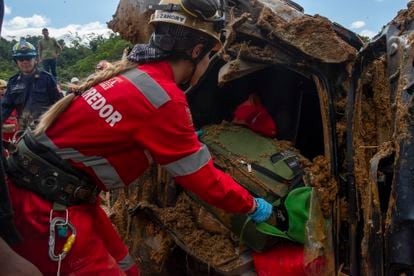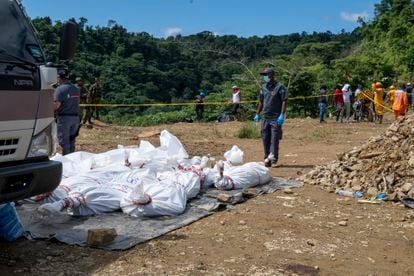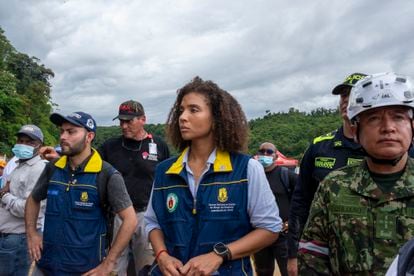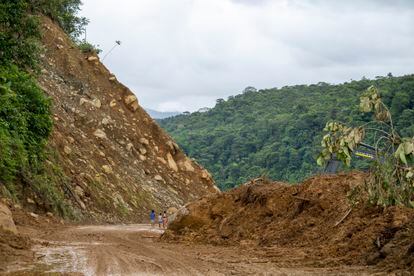Early on Saturday, James and Herminio Palacio saw the colossal landslide that, the day before, buried their brother and dozens of other people on the Quibdó-Medellín highway, near El Carmen de Atrato (Chocó). They arrived at the site with the intuition that Pedro Leonel Palacio could be alive, as well as about 20 wounded people who had been transferred to Medellín during the night. But, seconds after arriving, they learned that the rescue forces were carrying Pedro's body up the slope that separates the river and the road. “He already came in the bag,” they say in reference to some white sacks that accumulate next to a Prosecutor's truck.
Pedro, who worked as a security escort, is one of the 33 dead found between Friday night and Saturday noon. Like the majority of those affected, he was traveling from Quibdó to Medellín when intense rain caused a landslide that swept away the house in which dozens of undetermined travelers were taking refuge while they waited for the clearing. Contrary to what Peter's brothers expected, no person has been rescued alive on Saturday morning. The victims who remain to be found are buried deeper than the wounded evacuated at night and have less chance of having survived.
The slide occurred around four in the afternoon on Friday. The road was closed at kilometer 17 due to a smaller landslide that had occurred a few hours earlier a few meters away. Many travelers had already returned to Quibdó, but others remained with the expectation of continuing on their way when weather conditions improved. Alberto Olaya and Rocío Masso, a farmer and a retired kindergarten teacher from Carmen de Atrato, opened the doors of their house on the road to shelter the travelers. Now, the house no longer exists and has been replaced by tons of mud that descends about 30 meters to the river.

The improvised rescue operations center is on the side of the road, a few meters from the collapse. A whiteboard in the command post tent shows there are 239 people taking part in the rescue. They include military personnel, firefighters, police, Civil Defense officials, Prosecutor's Office personnel and members of the indigenous guard. The site has changed radically compared to the previous afternoon. The intense midday sun has replaced the rain and darkness. The place has also been filled with people from all over. The indigenous people of the neighboring communities, who emphasize their friendship with the owners of the buried house, are no longer the only rescuers.
Newsletter
The analysis of current events and the best stories from Colombia, every week in your mailbox
RECEIVE THE
Among the new rescuers is John Arrovaye, a 26-year-old from Antioquia who works at Latinco, the company that has the concession for the road. He is part of the team in charge of maintaining the road, which along its route has signs warning about the usual falling stones. He is used to moving through rubble, but he had never had to help rescue bodies. He comments that he was shocked that the first person he rescued on the day was a girl and that he thought that one day he could be the one who ends up buried.

John and his companions point out, while they rest, that in the morning the authorities explained to them some protocols to rescue the victims. “If the body has a part trapped in the mud, there is no need to pull. The idea is not to dismember them,” they say. They have to dig around the visible part to expose the rest of the body and be able to remove it easily.
The governor and the mayor
The camp comes to a boil when an Army helicopter lands and raises a cloud of dust in the surrounding area. Minutes later, the mayor of Carmen de Atrato and the governor of Chocó, Farlin Perea Renteria, appear at the command post. He gives her a detailed account of what happened in the last few hours. There are emphatically no clues as to how many missing people remain. Neither the owner of the buried house nor his daughter have been found and, according to the mayor, this indicates that there may be many more like them. “We don't know exactly, governor, how many people we are missing. It is said that there were 70 in the house, it is said that there were 80″, he says.

The mayor affirms that the operation does not lack personnel, but that it does need more resources. “I want to tell you that we are working with our nails, the Civil Defense did not even have a stretcher,” he laments. “My people are poor and peasants. It lasts only three days to sustain 239 people,” he adds. Both the local president and the leader of the firefighters of Envigado (Antioquia), Héctor Ortega, insist that they need to obtain machinery that will allow them to begin excavations at greater depths. “At the point of a pickaxe and a plate it will be impossible to find those who are a meter or a meter and a half below,” Ortega emphasizes.
Governor Córdoba is a 33-year-old lawyer who has revived hope for change in a department tired of apathy and with poverty figures greater than 50%. She agrees in part with the diagnosis regarding the lack of resources. “With this information, I believe that both the department and the municipality are not prepared for an emergency like this,” she says. But that's where the harmony with the mayor ends. Córdoba shows her annoyance with figures of injuries that do not coincide between what she has and what the blackboard says. Afterwards, she expresses her concern about the possibility that several bodies are not in the search area, but downstream.

Córdoba pauses for a few moments to respond to the mayor's concerns about the transfer of the bodies to Medellín and not to Quibdó, the capital of the department and origin of the majority of the dead. Several relatives are worried that the Prosecutor's Office will have to take the bodies so far—there are 230 kilometers between both cities—because Quibdó does not have the capacity to process so many bodies. The governor assures the mayor that the department will guarantee the transfer of the bodies to Quibdó once the necessary procedures are carried out in Medellín. It is the most concrete promise of a visit whose priority is the collection of information.
Outside the tent, several relatives are waiting who have already identified the bodies of their loved ones, which remain in the white bags lined up on the floor of a restricted area. They hope that the Prosecutor's Office will upload the bodies to a truck that will take them to Medellín, as already happened in the early morning with the first 17 that were found. After the meeting, the governor approaches them, gives them her condolences and promises that they will soon return from Medellín and be in Quibdó. Afterwards, she hugs them.
Among those relatives are Alex Pino and Yessid Perea, ex-partner and cousin of Leidi Laura Mosquera, respectively. They explain that she worked in a restaurant in Medellín, but that she had gone to visit them in Quibdó for the end of the year holidays and that she was returning to her house when the collapse occurred. Yessid, despite the hours that have passed since he identified her cousin, is still carrying the shovel with which she arrived in the morning to dig through the rubble. Like James and Herminio Palacio, she claims that she also thought she had some chance of finding her alive. While she says goodbye to her, other relatives prepare to continue the search for the missing people still buried.

Cristian Correa, the family psychologist
Cristian Correa Villa is a young psychologist at the San Roque Hospital, in Carmen de Atrato. He arrives at the camp in the late afternoon, when the movement has already decreased and the relatives of the victims are the ones who remain in the search area. He says he reached out to look for a mother he met Friday in the first hours after the collapse. She had been saved, but her son was in the rubble. “She said she wasn't leaving here until he found him. I guess she found it, otherwise she would be here,” he says. “I hope she calls me if she needs me,” he adds.
The psychologist explains that in the morning he was caring for a woman who arrived at the San Roque Hospital from Medellín. He was looking for her daughter, who lived in Quibdó and was traveling to the capital of Antioquia on the night of her collapse to visit her. However, after arriving at the hospital, he learned that her body was already in Medellín. Cristian then began with what he calls “psychological first aid.” “Many times it is not what they are told. It's about listening to her, asking her about her daughter and having her tell me,” he says.
Subscribe here to the EL PAÍS newsletter about Colombia and here to the channel on WhatsAppand receive all the information keys on current events in the country.
#lives #earth #swallowed #Chocó #don39t #people #missing
